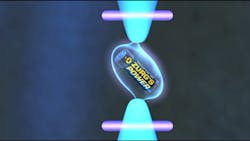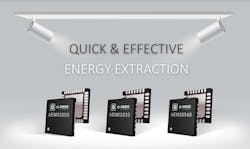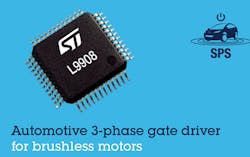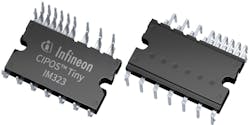This Week in PowerBites: Two Innovative Batteries Near Production, Student EV Hackfest
This article is part of the This Week in PowerBites Library Series.
Liquefied Gas Electrolyte Li-Ion Batteries Move Toward Commercialization
After winning an NSF Phase IIB SBIR grant in 2021, South 8 Technologies, a developer of electrolyte formulations for next-generation lithium batteries, has taken the next step in its commercialization efforts. The company raised $12M in Series-A financing*, which it will use to accelerate the commercialization of its liquefied gas electrolyte (LiGas) technology. Anticipated applications include electric vehicles, all-weather grid storage, defense, renewable energy, and aerospace.
South 8 says that the new electrolyte technology will enable production of low-cost, high-performance batteries that overcome the shortcomings of existing lithium-based liquid electrolytes and solid-state batteries still under development.
Unlike common battery electrolytes that are liquid at room temperature, or solid-state electrolytes, the company’s non-toxic LiGas technology uses solvents that are normally gaseous at standard pressure and room temperature. However, they may be liquefied under pressure and used as an electrolyte within the cell.
South 8 explains that batteries built using its electrolyte technology will have the following advantages:
- Increased safety: While conventional liquid electrolytes are a catalyst for thermal runaway, the LiGas electrolyte can safely and rapidly vent from a cell after physical or electrical abuse. Thus, the cell can fail safely without the risk of thermal runaway or thermal propagation.
- High energy density: The intrinsically high chemical stability and high conductivity of the LiGas electrolyte allow for the use of the highest-energy materials available, packing more energy into a cell.
- Wide operating temperature: The low freezing points of the LiGas electrolyte enable lithium batteries to perform in the most extreme climates at temperatures as low −60°C and up to +60°C.
- Material compatibility: All conventional cathode, anode, and separator materials are compatible with the LiGas electrolyte, allowing for simple integration into today’s gigafactories.
- Reduced cost: LiGas electrolytes apply established manufacturing techniques while considerably increasing factory utilization, enabling lower $/kWh for electric-vehicle and energy-storage-system applications.
- Recyclability: The LiGas electrolyte makes widespread adoption of battery recycling possible by removing the high-cost barrier of battery transportation to recycling centers at the end of life.
The company is in semi-stealth mode at the moment, but you can follow its future activities at https://south8technologies.com/.
*South 8's Series-A funding was led by Anzu Partners with participation from LG Technology Ventures, Shell Ventures, Foothill Ventures, and Taiyo Nippon Sanso Corporation (TNSC).
Lithium-Sulfur Batteries May See First Commercial Production Later in 2022
Could one of the planet's most abundant elements help battery makers build more powerful and rugged cells using much less of the world’s limited reserves of lithium? Berlin-based Theion, and its appointed CEO, Dr. Ulrich Ehmes, are confident that the company's lithium-sulfur cathode technology will be less expensive and triple the range and usage time of equivalent conventional lithium-ion cells.
Although the Li-S batteries are still in pre-commercial development, Ehmes recently announced the upcoming commercial availability of its crystal battery for applications later this year.
Theion’s battery innovation is based on sulfur, which can be harvested in abundance as a by-product of industrial processes without the cost or environmental impact of mining of traditional materials such as nickel and cobalt. As a result, sulfur is 99% cheaper to source than the cathode materials used in today's lithium-ion batteries. In addition, Theion’s battery cells require 90% less energy to produce, from raw material to finished cell.
Furthermore, Theion’s patented production process extends the lifecycle of batteries by combining sulfur’s crystal material properties with carbon nanotubes and a proprietary solid electrolyte. A pure sulfur wafer is grown via a direct crystal imprinting (DCi) method (no slurry coating, no solvents, no water, no drying) directly from molten sulfur in a few seconds.
The result is a cathode that can be grown to the shape and size required by the customer, experiences little or no volumetric fluctuation during the charge/discharge cycle, and is able to work at low porosity. A proprietary solid-state polymer electrolyte operates in the voids of the sulfur wafer.
By adding conductive paths, the company maximizes the use of the active material to achieve a high energy density. In Gen 1 and Gen 2 Crystal cells, lithium metal foil will be used as anodes, with the potential for other materials in future generations.
Theion's performance targets for its Gen 2 cells include:
- Gravimetric energy density ≥ 1,000 Wh/kg (Gen 4)
- Volumetric energy density ≥ 1,500 Wh/l
- Power capability ≈ 12.000 W/kg
- Cycle life ≥ 1,000 at 1 C
- Operational temperature −20 to 60 °C
The company will be shipping material later this year, first to aerospace customers as part of the qualification stage, then aircraft, air taxis, drones, mobile phones, and laptops, before servicing the electric flight and automotive sectors in 2024.
To accommodate the anticipated demand, plans are to add manufacturing facilities, beginning in Berlin, where its current cell design, prototyping, and testing facilities are located. Locations for follow-on gigafactories are not determined yet, but they will be located close to their customers, anticipated to be in Europe, Asia, and the US.
Editor's Note: These folks are dreaming big and it's hard to tell if they will succeed with their Giga-Plans. In any case, watching them go for it via their home page at https://www.theion.de/ will definitely be fascinating.
Constant-Voltage PMICs for Intermittent-Input Energy-Harvesting Arrangements
e-peas introduced three new power-management ICs (PMICs) designed especially for energy-harvesting systems. The new devices include constant input-voltage regulation, making them uniquely optimized for intermittent and pulsed-power inputs. The AEM00330 is a full power-management chip, complemented by the AEM00300 storage element charger. The potential applications for these devices include door access systems, smart switches for smart homes or smart buildings, point-of-sales (PoS) units, and smart running shoes.
Both devices are self-configurable, with the ability to automatically switch between buck, buck-boost, and boost operation. This enables faster adjustments with different source, storage, and load arrangements (step-up, step-down, etc.) and maximizes their energy-transfer capabilities.
To make the most of intermittent sources, both the AEM00300 and AEM00330 are designed to respond instantly to the presence of harvested power once a predefined threshold is exceeded. The operating input-voltage range goes from 140 mV to 4.5 V, so power levels of 3 µW to 570 mW can be managed. Another key feature is their ability to swap from powering the load or the storage element, giving greater flexibility to applications that should initially focus on one or the other.
When energy transfer from sources need to have a lower voltage than the storage element, the AEM00940 can provide a highly efficient boost solution. It has an LDO-based output and a selectable operating input voltage that spans from 50 mV to 4.5 V. All three devices can be utilized in energy-harvesting applications with single- and dual-cell supercapacitors; Li-ion, LiFePO4, LiPo, and NiCd thin-film batteries; and solid-state batteries. They feature selectable and adjustable storage-element protection mechanisms that guard against overcharge and overdischarge.
The AEM00330 is housed in a 40-pin QFN package format with 5- × 5-mm dimensions. The AEM00300 comes in a 4- × 4-mm, 28-pin QFN package, while the AEM00940 has a 5- × 5-mm QFN28 package. Each can be adapted to meet customers’ specific packaging needs and are available in a bare die format for high volume orders. Dedicated evaluation kits (EVKs) for each of the new PMICs will be available soon. For additional information, visit www.e-peas.com or contact [email protected]
Automotive-Rated Multi-Motor Gate Driver Simplifies Accessory Control
Created specifically 12-, 24-, or 48-V motor control applications in conventional and hybrid/electric vehicles, STMicroelectronics’ L9908 integrated automotive three-phase gate-driver unit (GDU) offers highly configurable input/output channels. Also in the mix are smart protection and diagnostic features that enable flexible, cost-effective designs.
The L9908 maintains dedicated source connections to the high- and low-side FETs of each half-bridge. As a result, users can configure the output channels independently to drive various types of loads. In addition, six separate pulse-width-modulation (PWM) input pins allow for independent management of the pre-driver stages for different motor-control strategies.
High accuracy is assured, with three differential current monitors for ground-referenced measurements and three channels for real-time phase-voltage monitoring. There’s also a rich set of diagnostic and protection features.
By combining high integration, flexibility, and accuracy, the L9908 simplifies design, saves space, and enhances control of low-voltage fluid pumps, pumps and blowers in ventilation and cooling systems, and electronic seat controls. Furthermore, it can be used in traction inverters for mild-hybrid internal-combustion-engine (ICE) vehicles and 48-V full-electric city cars.
Thanks to the L9908’s built-in diagnostics, it can be employed in safety-related systems such as autonomous emergency braking (AEB) and advanced electronic power steering (EPS), simplifying certification according to ISO 26262.
Safety features include SPI-programmable dead-time insertion with shoot-through diagnostic and protection, open-load detection, and short-to-ground/battery diagnostics. Also incorporated are an SPI-based temperature reading/warning function, ground-loss detection, over/undervoltage detection on the power-supply pins and FET-driver supply, system-clock monitoring, and a SPI window watchdog.
The flexibility to use the L9908 gate driver in single (12 V), dual (24 V), and 48-V battery applications comes from its wide motor supply-voltage range (4.5 to 75 V), with the ability to tolerate −14 to 95 V on motor-connection pins. The on-chip logic is supplied from an internally generated 3.3-V supply and digital I/Os are 3.3- and 5-V-compatible.
The L9908 is AEC-Q100 qualified and available now in a thermally enhanced TQFP48 package. Pricing starts at $3.56 for orders of 1,000 pieces. Contact your local ST sales office for further pricing options.
Tiny, Smart Motor-Control Module Integrates 600-V IGBT + SOI Driver
The CIPOS Tiny IM323-L6G is Infineon Technologies' latest member of the CIPOS Tiny Intelligent Power Module (IPM) family. Rated for 600 V/15 A, the new IPM integrates the company's TRENCHSTOP IGBT RC-D2 switches and its advanced SOI gate-driver technology to achieve maximum efficiency and improved reliability, along with reduced system size and cost. The integration of discrete power semiconductors and drivers simplifies and shortens the design process for major home appliances, in particular drives for room air conditioners.
The CIPOS Tiny IM323-L6G is optimized for three-phase inverters up to 1.2 kW and an operating range of 1 to 20 kHz. The 600-V TRENCHSTOP RC-D2 devices feature a monolithically integrated diode with a maximum junction temperature of 175°C for the switch. The IPM's integrated C5SOI gate drivers deliver negative voltage spikes at the motor outputs, as well as a high level of protection and fail-safe operation. In case of overcurrent and undervoltage, the IPM provides cross-conduction prevention and turn-off of all switches.
The IM323-L6G is molded in a robust and pin-compatible 33- × 19-mm2 DIP package with built-in NTC, which allows for high flexibility of the mechanical system design, as well as high reliability. Furthermore, full in-house production for the front-end and back-end provides supply security.
Availability
The IM323-L6G and iMOTION Modular Application Design Kit MADK can be ordered now. By the end of 2022, plans are to expand the CIPOS Tiny IM323 product range by including variants with 6 and 10 A. More information is available at www.infineon.com/CIPOS. Also, check out the datasheet at IM323-L6G/IM323-L6G2.
Engineering Students Invited to Hack a Cadillac EV in the U.S. DoE's Latest EcoCAR Challenge
This fall, teams of engineering students hailing from every corner of America will begin a four-year competition to show Detroit how EVs should really be designed. Using a 2023 Cadillac LYRIQ as their starting point, each team will be free to add, subtract, and innovate to create a vehicle that's more efficient, safer, and maybe even more fun to drive—all while remaining legally road-worthy in all 50 states.
Formally known as the EcoCAR EV Challenge, this vehicular hackathon is the latest in a long series of Advanced Vehicle Technology Competitions (AVTCs) that the U.S. Department of Energy (DoE) has been sponsoring since the 1990s. Also sponsored by General Motors and MathWorks, and managed by Argonne National Laboratory, the series of competitions has served as a proving ground for future automotive engineers and helped their universities explore the cutting edge of automotive engineering education.
Most of the previous Eco-Challenges focused on improving the fuel efficiency of various types of internal-combustion vehicles, including trucks and SUVs. In contrast, this latest four-year competition will challenge students to engineer a next-generation battery electric vehicle (BEV) that deploys connected and autonomous-vehicle (CAV) features to implement energy efficient and customer-pleasing features. It also must meet the automotive industry's increasingly aggressive decarbonization goals.
General Motors will donate a 2023 Cadillac LYRIQ to each team, challenging them to design, build, refine, and demonstrate the potential of their advanced propulsion systems and CAV technologies over four competition years. Teams will be tasked with complex, real-world technical challenges including enhancing the propulsion system of their LYRIQ to optimize energy efficiency while maintaining consumer expectations for performance and driving experience.
A foundational principle of EcoCAR is the use of “model-based design”—a mathematical and visual design approach using MATLAB and Simulink that enables users to manage projects quickly and cost-effectively, collaborate on designs, and develop complex embedded systems. MathWorks provides teams with a full suite of software tools, simulation models, training, technical mentoring, and operational support.
In addition, more than $6 million will be provided to the selected universities, including five minority-serving institutions, for students to pursue advanced mobility research and experiential learning. Officials at the EcoCar EV Challenge say that this investment supports the recruitment and retention of underrepresented minority students and faculty to help build an EV talent pipeline that reflects the diversity of North America.
The competition will kick off in Fall 2022 and conclude in May 2026. For more information, visit ecocarevchallenge.org or avtcseries.org.
Read more articles in the This Week in PowerBites Library Series







